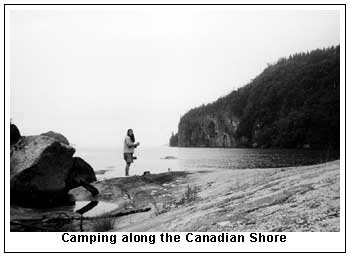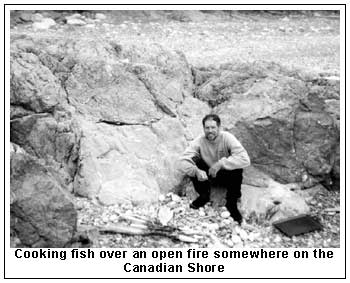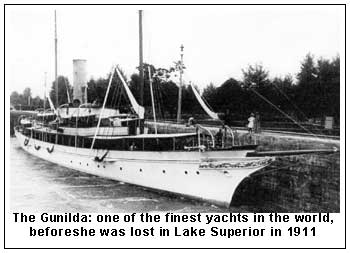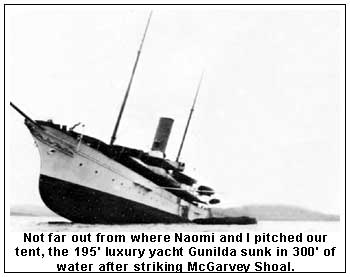|
Adventure Bound: A Father and Daughter
Circumnavigate the Greatest Lake in the World
By Carl Behrend
MARATHON AND PORT COLDWELL
 It was a cold windy morning as we broke camp. We got
ready to sail. The wind and waves were coming almost
directly at us. The wind was funneled into the cove.
This made it dangerous for us to launch the boat.
With some effort, we shoved off and started the
motor. The waves were huge as we made our way out of
the cove. The motor nearly came out of the water as
we were hit by one wave after another. The boat was
barely making any forward progress. The motor made a
loud moaning sound as it came out of the water after
each wave. Slowly, we made our way out of the cove
into the open lake. We were able to turn in an angle
that allowed the sail to catch the wind. Once it
did, we moved ahead more smoothly. But still, it was
a wild ride toward Marathon. The town was some 10
miles in the distance. It was a cold windy morning as we broke camp. We got
ready to sail. The wind and waves were coming almost
directly at us. The wind was funneled into the cove.
This made it dangerous for us to launch the boat.
With some effort, we shoved off and started the
motor. The waves were huge as we made our way out of
the cove. The motor nearly came out of the water as
we were hit by one wave after another. The boat was
barely making any forward progress. The motor made a
loud moaning sound as it came out of the water after
each wave. Slowly, we made our way out of the cove
into the open lake. We were able to turn in an angle
that allowed the sail to catch the wind. Once it
did, we moved ahead more smoothly. But still, it was
a wild ride toward Marathon. The town was some 10
miles in the distance.
We left Hattie’s
Cove early. The water was very rough and it was
misty and chilly. So by the time we got to Marathon
we were thoroughly drenched and cold. We pulled up
on a pebbly beach not far from the town.
By mid morning we
were approaching the town. It sat high on a hill. As
we neared the shore we could see someone coming down
to the shore to meet us. Naomi and I began to pull
the boat up. The visitor also helped us. Her name
was Kathy Gagnon. She said she had seen us coming in
off the lake. It was cold and we were wet. She asked
us if we had eaten any breakfast yet. She invited us
to her house. Naomi and I readily accepted her
invitation.
Just as we pulled in,
we saw someone watching from the lookout point above
the beach. When we got there, she was standing on
the shore. Her name was Kathy and she helped us pull
our boat up and right after a few minutes talking,
she invited us right over to her house for breakfast
and to dry some clothes.
So first we stopped at the grocery store, then went
to her house and she made us delicious pancakes,
(which I got the recipe for) and dried our clothes.
We sang her a couple of our songs.
Her husband came home for lunch so we got to meet
him too. He was very nice too. I fell asleep on
their couch while Dad and them talked in the
kitchen.
On the way, we stopped at a store for a few
supplies. We also refilled our gas can. The woman
was obviously a saint. She washed our clothes and
fed us without hesitation. Naomi and I rested after
breakfast. We told Kathy of our adventures and how
thankful we were that she had come along. She told
us that she was heavy-hearted over the illness of a
friend. So Naomi and I sang a couple of songs for
her and had a word of prayer to encourage her. After
giving us a ride back to the boat, our host watched
us as we shoved off into the open lake. She waved
goodbye as we sailed west.
We left Marathon around noonish and by that time it
was calm and foggy. I mean really foggy-the kind of
fog that’s so thick that it clings to everything and
you can’t see the nose on your face. It was very
slow and frustrating trying to get anywhere because
you never knew what was an island and what was a
bay. We were musing that if we hit a big enough
island we could just circle it all day without
knowing it.
 The fog made everything appear eerie. It was like we
were floating along on a big white blob that drifted
and twisted its fingers around everything and
muffled all sounds except for the drip, drip,
dripping of the trees. We had to be careful not lose
sight of the shore or we could easily get
disoriented and end up in the middle of the lake. The fog made everything appear eerie. It was like we
were floating along on a big white blob that drifted
and twisted its fingers around everything and
muffled all sounds except for the drip, drip,
dripping of the trees. We had to be careful not lose
sight of the shore or we could easily get
disoriented and end up in the middle of the lake.
There was a large paper mill and a nice-sized harbor
west of town. There were a few fishing boats
circling at the mouth of the harbor as we sailed
past in the fog. The fog grew thicker and thicker
until it was difficult to see the shoreline. We
groped our way along the shore, trying to make some
progress. The difficulty of this method of travel
was that when we came to a bay or an island, it was
hard to tell if we were following the shoreline or a
large island. We could have gone in circles for
quite a while and not known it.
We stopped at an island for a while. It had a
Pukaskwa pit, a stone cave and midget birch trees.
It was cool, so we ghosted silently along the shores
until we got to Port Coldwell.
By mid-afternoon we stopped on an island. The fog
had lifted a little. We found a spot that looked
interesting. There was a large field of stones
covering half the island. We expected to find some
Pukaskwa pits here and we did. There were some small
birch trees that had grown out of these piles of
stones that somehow were beautifully shaped by the
wind and weather. They were spaced intermittently
like someone had placed them there in this beautiful
rock garden park.
There was one Pukaskwa pit overlooking the channel
between the island and the mainland. No one knows
for sure the purpose of these pits. But they were
usually located in a place overlooking the lake
where the beautiful surroundings turned ones
thoughts to the Great Spirit. If they were made for
some religious ceremonies, they were surely in good
places.
Naomi and I shoved off and made our way along the
shore. The fog settled back in again as we made our
way past bays and islands. In one bay we found a
fishing tug anchored. So we took a few photos. It
made an interesting scene for us there in the fog.
Late in the day, as we followed the shore, I could
tell that we were out of the wind a bit. Perhaps we
were in the shelter of some island. As we made our
way along, Naomi and I kept our eyes open for a
campsite. Then we saw a large flat rock that might
possibly work. But we kept going. After a while we
came across what looked like an old shipwreck
sticking up out of the water. Upon closer inspection
it appeared to be some sort of mining barge. We
later learned the barge was used for mining gravel
when the Canadian-Pacific Railroad was built along
the shore. The barge’s steam boiler and machine
works were lying there half-submerged in the shallow
water. A beaver hut built on top was the only sign
of life that had used the barge in the recent past.
There were many wrecked ships along the shore. The
most interesting was a huge old barge that loomed up
out of the mist like the twisted skeleton of some
ancient leviathan. We found a really cool rock to
camp upon in Port Coldwell. It was a big rock out in
the channel. Wow. I haven’t written in a couple of
days. A lot has happened since I last wrote. We left
Port Coldwell around 8 a.m. and headed for Terrace
Bay. I have to start writing in this more I’m
starting to forget stuff.
Feeling our way through the fog, we continued along
the shore not finding a good camping spot. We came
to a large rock cliff. Following the cliff at the
water’s edge, we felt the temperature drop and the
wind pick up a little. I told Naomi that we must be
back into the open lake.
“Let’s turn around and go back to that flat rock and
camp,” I said.
“Okay, dad. That looked like the best spot.”
We would find the nearest spot to camp and set up
the tent for the night. So we backtracked for about
a half hour, past the old barge again and finally we
made it back to the large flat rock we had seen
earlier. We pulled the boat up and began to set up
camp. A flat rock doesn’t sound like a very
comfortable place to pitch a tent. But compared to
the cobblestones we had camped on before, this was
great.
During the night, a severe thunderstorm rolled
through the area. But we stayed warm and dry in our
little tent. The only other sound during the night
was from the Canadian-Pacific Railroad train that
went by in the distance.
In the morning the fog had lifted. Although it was a
bit hazy, we could see much better. The rock cliff
that was a half-hour’s traveling through the fog was
now visible and only 75 yards from our campsite. Our
perception was much better without the fog.
Naomi and I now decided we must be in Port Coldwell.
Years ago, there had been a small town here in 1910.
The family of Henry Gerow and his six sons were
commercial fishermen here. There was a little store
near the Canadian-Pacific Railway Line. But now, the
only signs of human activity were the old barge and
a couple of old hulks that had once been wooden
boats lying along the shore.
Naomi and I broke camp early again and headed west.
The winds were still very light, causing us to use
our motor a lot and use up our small supply of
gasoline. Just about the time we ran out completely,
the sun came out and the breeze picked up. The wind
filled our sails. Studying our map we figured we
could stop at Jackfish Bay and get some gasoline. We
pulled up at the mouth of the river. But after
looking around we decided we needed to be on the
other side.
We headed for Jackfish Cove. It was a bad day for
sailing-foggy, no wind and almost out of gas. We
prayed and God really blessed. We pulled into
Jackfish Bay on our last bit of gas. Just as we
approached the bay, the fog lifted, the air
brightened and the sun came out. A nice breeze in
the sails pushed us into the bay. It was then we
discovered from reading Bonnie Dahl’s cruising guide
that the town of Jackfish no longer existed.
 A strong current kept us from going up the river and
with no gas we couldn’t use the motor. So we
launched the boat into what were now big breakers.
We tacked out far enough to reach a point across the
mouth of the river. We found a path heading toward
some cabins. At one of the cabins we found three
guys building an addition. Naomi and I talked with
them. They said there was no longer a town at
Jackfish Bay. But they did give us enough gasoline
to fill our can. They told us about the Slate
Islands. There were caribou on the island and also
some cabins that the owners left open to whoever
wanted to use them. A strong current kept us from going up the river and
with no gas we couldn’t use the motor. So we
launched the boat into what were now big breakers.
We tacked out far enough to reach a point across the
mouth of the river. We found a path heading toward
some cabins. At one of the cabins we found three
guys building an addition. Naomi and I talked with
them. They said there was no longer a town at
Jackfish Bay. But they did give us enough gasoline
to fill our can. They told us about the Slate
Islands. There were caribou on the island and also
some cabins that the owners left open to whoever
wanted to use them.
But there were some cabins there with people working
on them-two old people with heavy accents-a
middle-aged guy and a big old guy who looked like
Santa Claus. They were very nice and gave us some
gas. We headed off towards Terrace Bay, bypassing
the Slate Islands (which I hear are crawling with
caribou). They say there are nice cabins out there
open to boaters. I will have to go over there
sometime.
Naomi and I thanked them and made our way back to
the beach, which stretched for several miles. In the
distance were the Slate Islands, looking very
beautiful in the midday sun some 10 miles away.
Naomi and I would sure like to explore them. But we
decided to keep going. We again swore we would make
our “Island Tour” another season.
SHIPWRECK
We sailed west under fair skies. The winds were
favorable that day until we got close to Terrace
Bay. A thunderstorm was quickly moving in with great
bolts of lightning and thunder crashing loudly. We
headed for the nearest spot to pull in. We got the
boat pulled up. It was beginning to rain. So we took
the rain fly for the tent and bent down a little
tree. We threw the rain fly over it, making a little
shelter. Then Naomi and I built a fire to make a hot
cup of mocha. We also wanted to use the fire to warm
ourselves.
Just before Terrace Bay, a thunderstorm overtook us
and we had to pull up on a pebbly beach and throw
the rain fly over a tree. We quickly built a little
fire and made some hot mocha and passed the time not
unpleasantly. Thus the mocha tent was born. It was
the first of many. After the storm broke, we set out
for Terrace Bay again.
Fortunately, the storm didn’t last long. Soon we
were on our way again. After sailing a while, we
pulled up on a beach near Terrace Bay. We were near
the mouth of a river that had a large waterfall.
Naomi and I caught a ride into town with an older
couple from Rossport, Ont. The woman said that her
son had a large trimaran (meaning three hulls)
sailboat at Rossport. She was meeting him there the
next day. Naomi and I had a meal at a restaurant and
picked up a few supplies. We also found some maps at
the visitors’ center. One of the boys working there
gave us a ride back down to the boat. We thanked him
and we were on our way again.
Soon, we pulled up on the beach near a waterfall. It
was the biggest Canadian city we had been to yet,
about 6,000 people. So they had just about
everything we needed. We went out and ate Chinese
food. Then we went to a tourist info place to get a
map. A young Canadian guy took us back to the beach.
We hitched a ride to town with an elderly couple who
own a trimaran in Rossport.
By evening we were somewhere near the Schreiber
Channel. The islands offered us some protection from
the open waters of Lake Superior. As we entered the
channel and began to look for a place to camp for
the night, the sun was setting. As we were setting
up camp, the red and gold of the sunset gave us a
spectacular view, making us feel welcome on this
rugged Canadian shore.
We sailed for Rossport again that evening, but only
made it to a little channel outside of town. We
camped on a rock island that had little bluebells
growing all over it. It was a very pretty spot.
Our camp was overlooking the place of another
interesting shipwreck. But this was no ordinary
shipwreck. The 185-foot, 385-ton luxury yacht
Gunilda was owned by one of the richest men in the
world-William Lamont Harkness. He was the heir of
his father-in-law’s Standard Oil Company fortune.
Harkness and his family were enjoying a leisurely
trip along the Canadian shore. It was 1911. Harkness
had a professional captain and crew of considerable
size. But there is a saying that says, “Pride goeth
before destruction.” And it certainly was true in
this case.
Days before at Coldwell Harbor, Harkness had made it
known to locals that he was headed for Rossport and
then on into Nipigon Bay. A thoroughly experienced
local man named Donald Murray offered to pilot the
Gunilda into Nipigon Bay. He would do this for the
sum of $15. Despite his wealth, Harkness brusquely
rejected the offer saying it was too much. The next
day, while Harkness was loading coal at Jackfish
Bay, similar inquiries brought an offer from Harry
Legault to pilot the boat to Rossport. He wanted $25
and train fare back. Although Captain Corkum and his
crew thought this was a reasonable offer, Harkness
was outraged at the preposterous fee and dismissed
the whole idea. Entering Schrieber Channel, the
captain saw no shoals marked on their U.S.
navigational charts. If they would have had Canadian
charts, McGarvey’s Shoal would have been marked. But
with 300 feet of water showing on his chart, he
confidently shoved the engine telegraph to “full
ahead.”
The Gunilda cruising ahead at full speed was a thing
of beauty. With the same arrogance surrounding the
ocean liner Titanic, which would sink a year later,
the Gunilda was blindly racing ahead in the pride of
wealth and security. Harkness and his family were
enjoying the scenery. Suddenly, there was a
tremendous shock, which threw the passengers and
crew into disarray. The shelves onboard were cleared
of the yacht’s prized china.
The force of the collision caused the ship to be
carried 85 feet up onto McGarvey Shoal. There she
sat with her bow breaching out of the water. One of
the grandest yachts the world had ever seen was now
helpless. The captain and crew were able to take the
lifeboats into Rossport where the owner was able to
telegraph for a wrecking tug from Fort William,
which was over on Thunder Bay.
When the tug James Whalen arrived, Harkness was
eager to re-float his yacht. But the experienced
Capt. Whalen suggested there was a danger of the
boat “misbehaving.” He suggested that he return to
Thunder Bay to retrieve two barges to support the
aft end of the yacht.
“Never mind that,” Harkness snapped. “Just pull her
off.”
“But suppose she lists or twists?” Whalen said. “I
still think we should have a couple of scows lashed
to her.”
“Pull! Just pull,” Harkness yelled.
The tug captain did just that. After several
attempts, the Gunilda began to move. But instead of
sliding evenly into the water, she took a starboard
list. Her aft rail went under, causing her to gulp
in large amounts of the cold water of Nipigon Bay.
So simple had the salvage operation appeared that no
one had closed the portholes or secured the
companion way doors. In a few minutes it was all
over. The Gunilda slid backwards and disappeared
into 300 feet of water. And there the mighty yacht
rests to this day. What had once been one of the
finest ships in the world was now silent in the icy
depths of Lake Superior.
The red and gold of the sunset over the wild and
lonely wave-lapped shores of Nipigon Bay made it
even more unbelievable that just outside our tent
door in the Canadian wilderness lie this once
beautiful ship. This was indeed silent testimony to
the pride and arrogance of wealth. Naomi and I slept
peacefully that night. Our 16-foot sailboat was
pulled safely onto shore next to the tent. The
lapping of the waves on the shore was the only
sound.
This is the ninth of a series of excerpts from Carl
Behrend’s book Adventure Bound. For more
information on how to purchase books, CD’s or to
arrange bookings call
906-387-2331 or visit
www.greatlakeslegends.com.
TOP
|